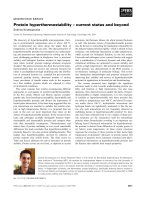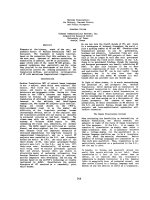TELECOMMUNICATIONS NETWORKS – CURRENT STATUS AND FUTURE TRENDS pot
Bạn đang xem bản rút gọn của tài liệu. Xem và tải ngay bản đầy đủ của tài liệu tại đây (18.08 MB, 458 trang )
TELECOMMUNICATIONS
NETWORKS –
CURRENT STATUS
AND FUTURE TRENDS
Edited by Jesús Hamilton Ortiz
Telecommunications Networks – Current Status and Future Trends
Edited by Jesús Hamilton Ortiz
Published by InTech
Janeza Trdine 9, 51000 Rijeka, Croatia
Copyright © 2012 InTech
All chapters are Open Access distributed under the Creative Commons Attribution 3.0
license, which allows users to download, copy and build upon published articles even for
commercial purposes, as long as the author and publisher are properly credited, which
ensures maximum dissemination and a wider impact of our publications. After this work
has been published by InTech, authors have the right to republish it, in whole or part, in
any publication of which they are the author, and to make other personal use of the
work. Any republication, referencing or personal use of the work must explicitly identify
the original source.
As for readers, this license allows users to download, copy and build upon published
chapters even for commercial purposes, as long as the author and publisher are properly
credited, which ensures maximum dissemination and a wider impact of our publications.
Notice
Statements and opinions expressed in the chapters are these of the individual contributors
and not necessarily those of the editors or publisher. No responsibility is accepted for the
accuracy of information contained in the published chapters. The publisher assumes no
responsibility for any damage or injury to persons or property arising out of the use of any
materials, instructions, methods or ideas contained in the book.
Publishing Process Manager Martina Durovic
Technical Editor Teodora Smiljanic
Cover Designer InTech Design Team
First published March, 2012
Printed in Croatia
A free online edition of this book is available at www.intechopen.com
Additional hard copies can be obtained from
Telecommunications Networks – Current Status and Future Trends,
Edited by Jesús Hamilton Ortiz
p. cm.
ISBN 978-953-51-0341-7
Contents
Preface IX
Part 1 New Generation Networks 1
Chapter 1 Access Control Solutions
for Next Generation Networks 3
F. Pereniguez-Garcia, R. Marin-Lopez
and A.F. Gomez-Skarmeta
Chapter 2 IP and 3G Bandwidth Management
Strategies Applied to Capacity Planning 29
Paulo H. P. de Carvalho, Márcio A. de Deus
and Priscila S. Barreto
Chapter 3 eTOM-Conformant IMS Assurance Management 51
M. Bellafkih, B. Raouyane, D. Ranc,
M. Errais
and M. Ramdani
Part 2 Quality of Services 75
Chapter 4 A Testbed About Priority-Based
Dynamic Connection Profiles
in QoS Wireless Multimedia Networks 77
A. Toppan, P. Toppan, C. De Castro and O. Andrisano
Chapter 5 End to End Quality of Service in UMTS Systems 99
Wei Zhuang
Part 3 Sensor Networks 127
Chapter 6 Power Considerations for Sensor Networks 129
Khadija Stewart and James L. Stewart
Chapter 7 Review of Optimization Problems
in Wireless Sensor Networks 153
Ada Gogu, Dritan Nace, Arta Dilo and Nirvana Meratnia
VI Contents
Part 4 Telecommunications 181
Chapter 8 Telecommunications Service Domain
Ontology: Semantic Interoperation
Foundation of Intelligent Integrated Services 183
Xiuquan Qiao, Xiaofeng Li and Junliang Chen
Chapter 9 Quantum Secure
Telecommunication Systems 211
Oleksandr Korchenko, Petro Vorobiyenko,
Maksym Lutskiy, Yevhen Vasiliu and Sergiy Gnatyuk
Chapter 10 Web-Based Laboratory
Using Multitier Architecture 237
C. Guerra Torres and J. de León Morales
Chapter 11 Multicriteria Optimization
in Telecommunication Networks
Planning, Designing and Controlling 251
Valery Bezruk, Alexander Bukhanko,
Dariya Chebotaryova and Vacheslav Varich
Part 5 Traffic Engineering 275
Chapter 12 Optical Burst-Switched
Networks Exploiting Traffic
Engineering in the Wavelength Domain 277
João Pedro and João Pires
Chapter 13 Modelling a Network Traffic Probe
Over a Multiprocessor Architecture 303
Luis Zabala, Armando Ferro,
Alberto Pineda and Alejandro Muñoz
Chapter 14 Routing and Traffic Engineering
in Dynamic Packet-Oriented Networks 329
Mihael Mohorčič and Aleš Švigelj
Chapter 15 Modeling and Simulating
the Self-Similar Network Traffic
in Simulation Tool 351
Matjaž Fras, Jože Mohorko
and Žarko Čučej
Part 6 Routing 377
Chapter 16 On the Fluid Queue Driven by
an Ergodic Birth and Death Process 379
Fabrice Guillemin and Bruno Sericola
Contents VII
Chapter 17 Optimal Control Strategies for
Multipath Routing: From Load Balancing
to Bottleneck Link Management 405
C. Bruni, F. Delli Priscoli, G. Koch, A. Pietrabissa and L. Pimpinella
Chapter 18 Simulation and Optimal Routing
of Data Flows Using a Fluid Dynamic Approach 421
Ciro D’Apice, Rosanna Manzo and Benedetto Piccoli
Preface
In general, all-IP network architecture only provides “Best Effort” services for large
volume of data flowing through the network. This massive amount of data and
applications in different areas increasingly demand better treatment of the
information. Many applications such as medicine, education, telecommunications,
natural disasters, stock exchange markets or real-time services, require a superior
treatment than the one offered by the “Best Effort” IP protocol.
The new requirements arising from this type of traffic and certain users' habits have
produced the necessity of different levels of services and a more scalable architecture,
with better support for mobility and increased data security. Large companies are
increasing the use of data content, which requires greater bandwidth. Video-
conferencing is a good example. There are also delay-sensitive applications like the
stock exchange market.
The relentless use of mobile terminals and the growth of traffic over
telecommunication networks, whether fixed or mobile, are a true global phenomenon
in the field of telecommunications. The increasing use of mobile devices in recent years
has been exponential. Nowadays, the number of mobile terminals exceeds that of
personal computers. At the same time, we see that mobile networks are a good
alternative to complement or replace existing gaps for Internet access in fixed
networks, especially in developing countries.
The growth in the use of Telecommunications networks has come mainly with the
third generation systems and voice traffic. With the current third generation and the
arrival of the 4G, the number of mobile users in the world will exceed the number of
landlines users. Audio and video streaming have had a significant increase, parallel to
the requirements of bandwidth and quality of service demanded by those
applications.
The increase in data traffic is due to the expansion of the Internet and all kinds of data
and information on different types of networks. The success of IP-based applications
such as web and broadband multimedia contents are a good example. These factors
create new opportunities in the evolution of the Telecommunications Networks. Users
demand communications services regardless whether the type of access is fixed or via
X Preface
radio, using mobile terminals. The services that users demand are not only traditional
data, but interactive multimedia applications and voice (IMS). To do so, a certain
quality of service (QoS) must be guaranteed.
The success of IP-based applications has produced a remarkable evolution of
telecommunications into an all-IP network. In theory, the use of IP communications
protocol facilitates the design of applications and services regardless the environment
where they are used, either a wired or a wireless network. However, IP protocols were
originally designed for fixed networks. Their behaviour and throughput are often
affected when they are launched over wireless networks.
When it comes to quality of service in communications, IP-based networks alone do
not provide adequate guarantees. Therefore, we need mechanisms to ensure the
quality of service (QoS) required by applications. These mechanisms were designed
for fixed networks and they operate regardless the conditions and status of the
network. In wireless networks (Sensor, Manet, etc.), they must be related to the
mobility protocols, since the points where a certain quality of service is provided may
vary. The challenge is to maintain the requested QoS level while terminals move on
and handovers occur.
The technology requires that the applications, algorithms, modelling and protocols
that have worked successfully in fixed networks can be used with the same level of
quality in mobile scenarios. The new-generation networks must support the IP
protocol. This book covers topics key to the development of telecommunications
networks researches that have been made by experts in different areas of
telecommunications, such as 3G/4G, QoS, Sensor Networks, IMS, Routing, Algorithms
and Modelling.
Professor Jesús Hamilton Ortiz
University of Castilla La Mancha
Spain
Part 1
New Generation Networks









